ROMA HALL STORY
“Roma Hall; Jazz, Blues and Soul at the Corner of Franklin and Division,” by Kim Rush, John Russo and Martin Starr
This article contains excerpts from a broader and more detailed article about the G.B. (Giovanni Battista) Russo family and their Roma Hall, located at the north-east corner of Division and Franklin from 1930-1991. Read further to learn why Roma Hall is one of Grand Rapids’ most historic and significant musical venues:
The Creation of Roma Hall
Before 1930, the G.B. Russo family resided in apartments above his grocery store, some of which had windows which faced west, overlooking bustling South Division Avenue. All of G.B.’s children were born in these apartments. He also rented space within this same area to various tenants, including an insurance agency and Laura Wells, a dance teacher.
In the late 1920s, a fire damaged the lower level of 746 South Division as well as the family apartments on the second floor. G.B.’s daughter, Jennie (Russo) Moschetti, stated that there were large wooden boxes located in the open lot next to the building which caught on fire, with flames spreading to the Russo property. Unfortunately, the building was uninsured. Rarely lacking innovative concepts to create income, G.B. decided to remodel a portion of the upstairs to create a rental hall. He called it Roma Hall, and it was built next to remaining Russo family apartments. These apartments and the store below were far from quiet, due to the sounds from the street or from the hall. The first Grand Rapids city directory listing for Roma Hall was entered in 1930.
Russo received help from his daughter Rose, a dancer, who was so enamored with her father’s new business venture that she left school to work at Roma Hall in the 1930s. While attending college, his son Frank also worked at Roma Hall during breaks and in the summer. G.B’s youngest brother Joe, his only sibling born in the United States, performed with a band at Roma Hall in the capacity of a drummer. He also served as a bouncer.
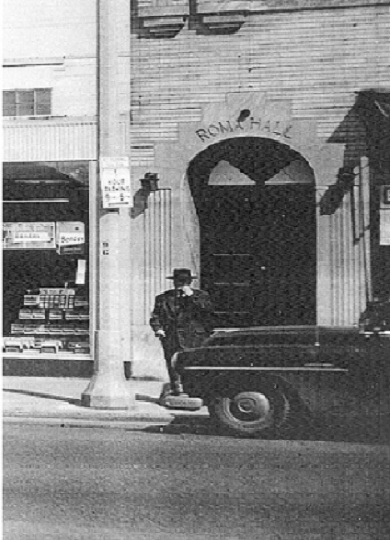
1958 view of the South Division entrance to Roma Hall (1)
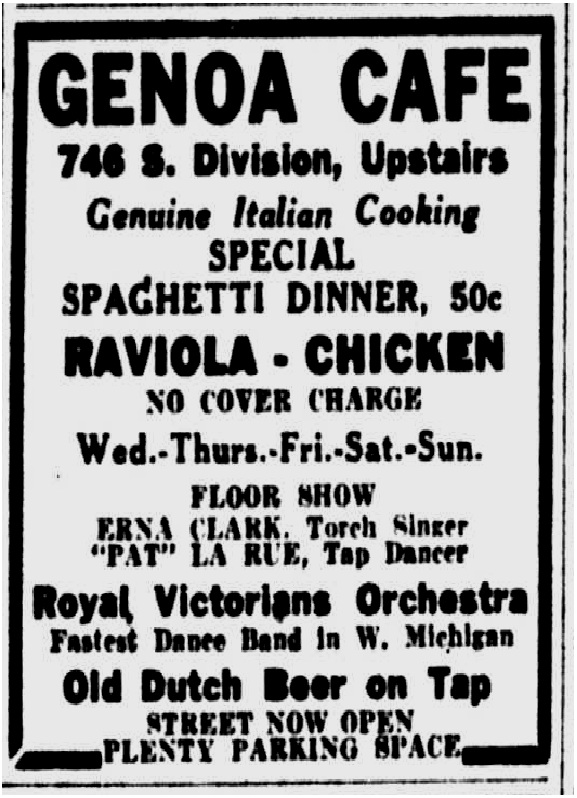
Grand Rapids Press advertisement for G.B. Russo’s Genoa Café from 12.2.33 (2)
The first Grand Rapids Press advertisement for Roma Hall appeared in December of 1933, boasting “floor show” entertainment featuring a torch singer, a tap dancer, as well as the Royal Victorian Orchestra. Italian food and beer were available. Instead of renting Roma Hall to clients, G.B. created his own nightclub or “beer garden,” modeling his business after a number of similar current night spots in the Grand Rapids area, such as Little Eden at 1944 Knapp N.E. There were at least three other nightspots on the same street as Russo’s place, namely The Chicken Coop at 4138 South Division, the Brown Derby, located south of 4000 South Division and The Southern Barbeque at 4157 Division. Most “cafes” served food and alcoholic beverages after the end of prohibition and catered to the current popularity of “floor shows,” and providing dancing with jazz orchestras.
G.B.’s “Genoa Café” lasted a little over a year. Advertisements appeared in the Grand Rapids Press from 12.2.33 until 2.10.34. During that summer, Russo adopted a new name for his venue, the “Russo Café. At this point, his dance hall was still located alongside the amalgam of family apartments. Based on the advertisements, there appears to have been little change in the business format other than the name change. G.B. was still running his own nightclub, selling his familiy’s Italian culinary creations, as well as beer and wine to his customers. Russo Café ads ranged from 7.34.34 until July of 1935. The content of the advertisements varied from week to week. For example, the show advertised on July 19, 1934 featured the combination of a boxing match and a floor show, in addition to selling chicken dinners, while also claiming that he had hired the best band in town. On the nights that the café was closed he’d rent the hall for various events such as private parties for the Italian and Syrian community, advertised weekend public dances, jam sessions, weddings, black cotillion debutante balls, political rallies, NAACP and Urban League meetings, dinners, meetings, conventions, parties, and concerts.
Dances and floor shows held at Roma Hall commonly featured African-American entertainers. Though most white-owned jazz places in Grand Rapids would occasionally employ black musicians, generally their clientele was white. All musicians, regardless of their race, were discouraged from mingling with patrons. Benny Carew was performing at a “white” café called Hattem’s as early as April of 1938. He was a black musician who nearly dominated the entire jazz scene in Grand Rapids for decades, at least in the sense of being steadily employed.
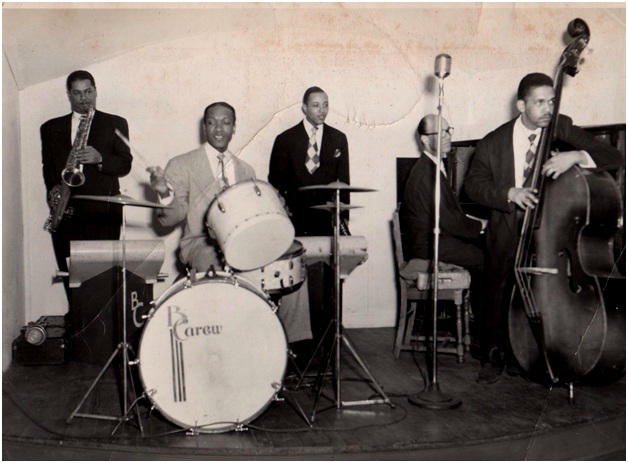
Benny Carew at the drums, Paul Bryant on sax at the far left, man in center unknown, Harold “Popeye” Booker on piano, and possibly Pete Glover on upright bass. (3)
Herman Curtis was probably the first African-American jazz musician to live and perform this type of music in Grand Rapids, as early as 1919. He was introduced in 1935 Roma Hall ads as “The Clown Prince of Jazz.” This was definitely a derivative title, yet accurately reflects the humorous flavor of his personality and performances. Over the course of his career, the names of his bands, such as Curtis Satonic 9-Piece Band of Grand Rapids, the Dusky Devastators of the Depression, Chocolate Vagabonds, NBC (Nothing But Curtis), and Herman Curtis and the Jazz Hounds display his infatuation with whimsy.
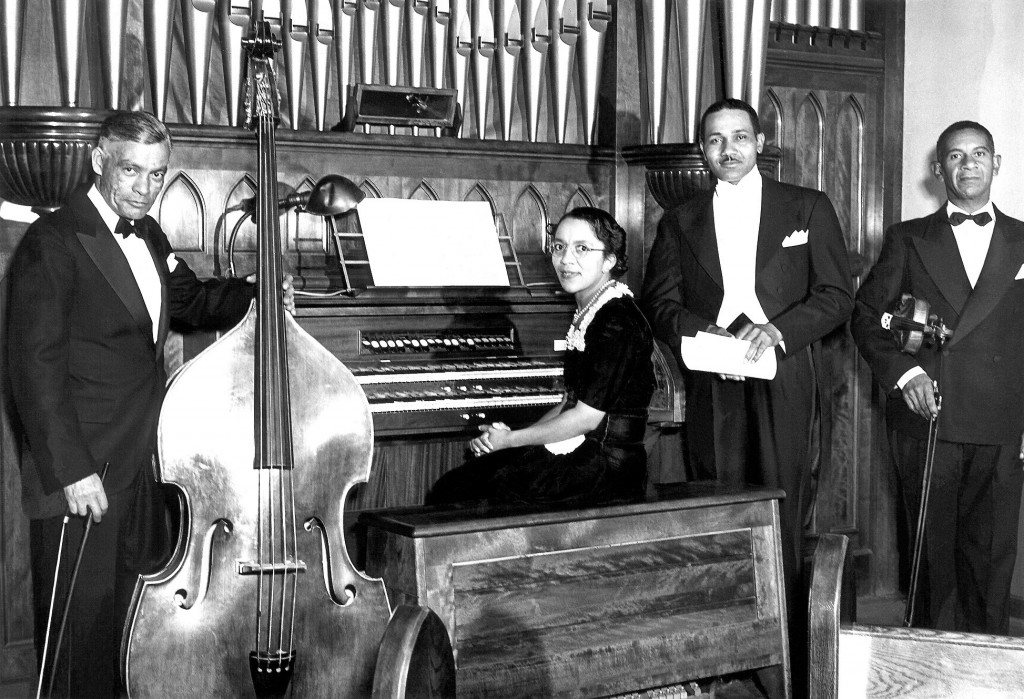
Left to right: the Herman Curtis Band; Fay Ebbo, bass, Edith Rambeau, keyboards, vocalist Cornelius White and Herman Curtis, with the violin and bow. (4)
Curiously, during the last month that Russo Café advertisements appeared in the newspaper, G.B. posted a relentless battery of advertisements spanning fourteen days. Five months later, his youngest brother Joe opened his own nightclub named Indian Village. It was located at 3854-62 Division near Bigelow Field, at Loraine and Division. Joe played drums for Roma Hall engagements and was always well connected with the local jazz music scene. He played a very sparse, portable trap set consisting of a high hat, snare and small symbol. He was also a close friend of Gerald Ford, having played football together at South High School. Joe was G.B.’s only sibling to have been born in the United States, as well as the last person to be living in the Russo complex before it was torn down in 1991.
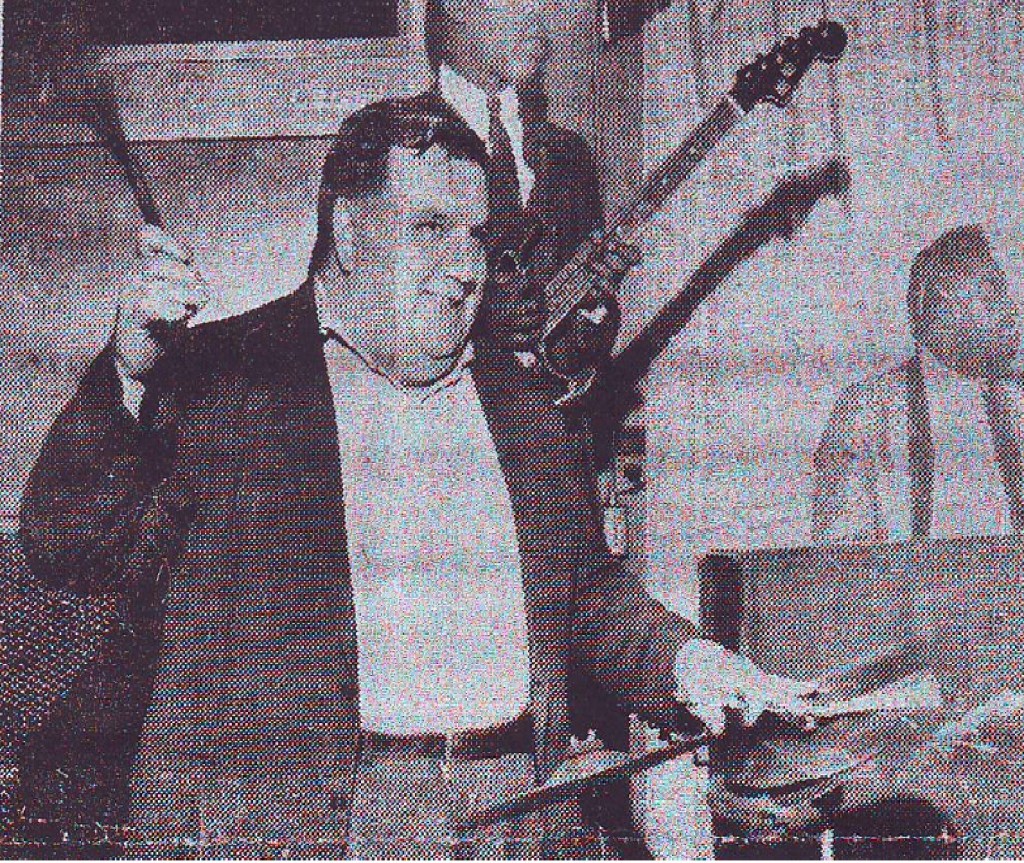
Joe Russo at the drums, in the 1960s (5)
Joe ran ads for his Indian Village nightclub beginning on 1.36 through 5.37, though it was operational as late as 1938. When G.B. quit advertising for Russo Cafe in late July of 1935, it probably had something to do with the revocation of his beer and wine license, as well as becoming overwhelmed with the responsibilities of his other businesses. He hired a lawyer named John VanderWal to settle his problem with the city commission. Furthermore, G.B. may have chosen to support his brother by electing to not compete against Joe’s new club. It is also likely that he was negotiating a deal with “Club Indigo” founders, namely attorneys Floyd Skinner and John Shakelford, and mortician Milo Brown. They were seeking to secure Roma Hall as the location for their new night club.
On September 26, 1936, Mrs. Floyd H. Skinner composed a column which described social events staged by Grand Rapids’ African-American community. It was posted regularly in the Chicago Defender newspaper. Her article announced the opening of “The Club Indigo, Inc. …organized for the social, athletic, and civic advancement of our group. It is intended that a first class night club to be opened in the near future where meals, beer, mixed drinks, and dancing may be enjoyed by its members and their guests in a refined atmosphere as provided by law. Mr. Milo M. Brown, popular local undertaker, is president and manager of said Club, and announces that the club, located at 746 South Division Avenue, will be open for business in the very near future.” (6)
The entertainment provided at Club Indigo’s frequent dances resembled popular ”floor shows” of that time period, similar to Idlewild’s presentations. Pierson Smith served shortly as their first M.C. Johnny Edwards, from Idlewild’s Paradise Club eventually served in this same capacity. They booked talent from Lansing, Saginaw, Battle Creek, Texas, Chicago, Kansas City, Detroit, St. Louis, and New York City, though not nationally renowned acts. At that time, Roma Hall was less than 2,000 square feet, and could not have accommodated a huge crowd. This venue was generally open three to four nights per week, and was operated by the Club Indigo, not the Russo family.
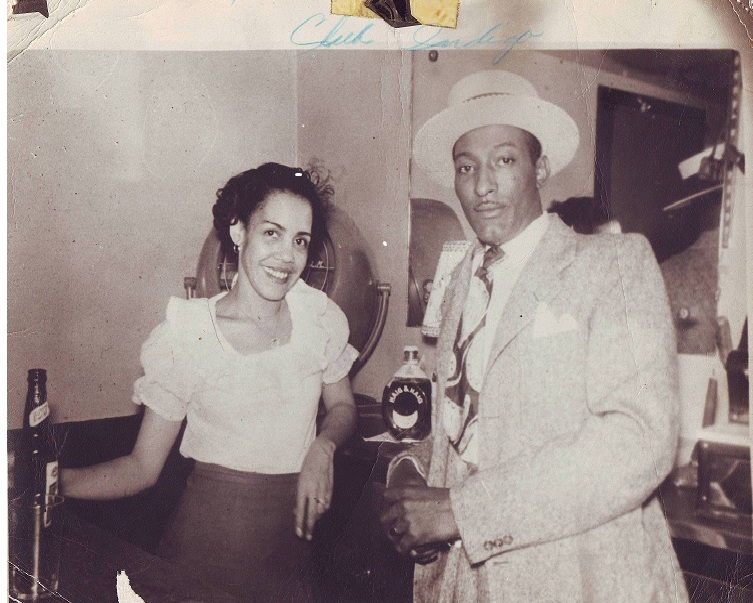
A picture taken at the bar of Club Indigo with Maxine (Young?) and Jerry “Fast Black” Lamar. Jerry served as secretary of Club Indigo in 1939. (7)
An African American theatrical company performed a musical comedy entitled “Shuffle Along” at Keith Theater located at 113-121 Lyon N.W. in Grand Rapids on January 19, 1937. Later that evening, the entire cast was invited to Club Indigo. They provided entertainment for the audience. One member of the cast was an eighteen year old pianist from Chicago named Nat (“King”) Cole. His band played that night, though this was well before he enjoyed his highly successful recording career. (8)
On April 1, 1939, Mrs. Skinner’s column spoke of the club being “beautifully redecorated and remodeled and open nightly under new management.” Club Indigo appears to have operated at Roma Hall until at least February of 1940. Club Indigo listings in the Grand Rapids city directories disappear in 1940. According to a Crisis magazine article from April of 1939, a charity dance for the Grand Rapids Youth Council was held by Club Indigo, although the location of the event was not specified. (9)
Music for this event was furnished by the Club Indigo Orchestra and the Federal Music Project (WPA) band. Gene Seals performed with the local WPA (Works Project Administration) band and served temporarily as leader of the Club Indigo house band. Arnold Allen and Bennie Carew also assumed the role of house band leader, though it has not been documented that they were members of the WPA band. From 1935-1943 the WPA created both an African-American and white jazz band in Grand Rapids under the auspices of the FMP (Federal Music Project). Numerous quality jazz musicians were drawn to Grand Rapids to apply for these paying positions. One objective of the FMP was to eliminate segregation of workers based on race. The original intent was to create one band in various designated cities. Inter-racial musicians generally worked well together, but it was found that establishments in some regions refused to hire black musicians. As a result, in markets such as Detroit and Grand Rapids, a separate African American band was created. A few of the members of the Grand Rapids WPA African-American band were Gene Seals, Burt Benton, Burt Brasier, Bernie Peacock, and Ham Allen.
Bennie Keys also performed regularly at Club Indigo, even before he moved to Grand Rapids in 1937, after his mother died. He was an established band leader, dance performer and instructor in Chicago during the 30s. Reportedly, he worked as a dance instructor, hired by Al Capone’s brother. He danced for Duke Ellington at the Cotton Club, where he also trained the other dancers. Bennie Keys, Jr. : “My dad really talked about New York a lot…. how he traveled with Louis Armstrong and Josephine Baker, the dancer. He dated her in the 1930s. He also mentioned knowing Sammy Davis, Jr. He met many of the big talents of that day, including ‘Bojangles’ and Lena Horne, whom he trained to dance.” During 1935 and 1936 Bennie and his band were working in Washington D.C. and New York City. He worked as a tap dancer, singer and drummer in Grand Rapids, performing regularly for many years. The late 40s and early 50s were the early days of Frank (Fred) Lamar’s legendary Horseshoe Bar at 333 Grandville Avenue, S.W. At that time, Benny served as the band leader for this nightclub. He also taught children how to dance and staged performances to showcase what they had learned. During the day he worked as a plumber. He died in Grand Rapids in 1988.
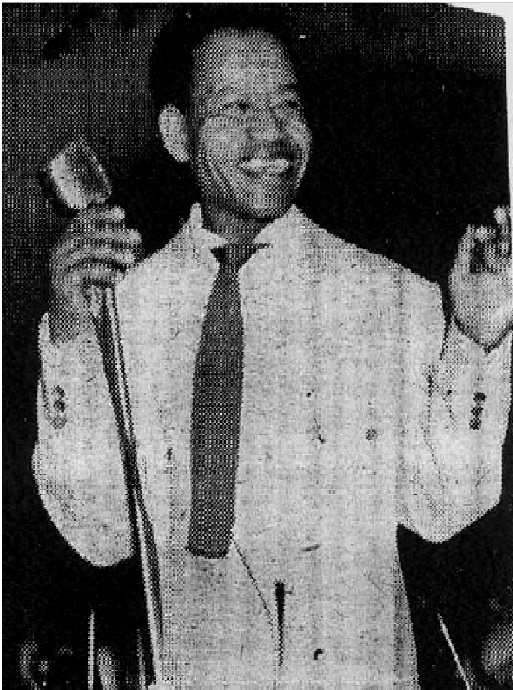
Bennie Keys (10)
Club Indigo members often extended their influence far beyond Roma Hall. During the late 30s, Milo Brown, John Shackelford, and Frank Lamar sponsored concerts, floor shows and dances around Grand Rapids, including numerous typically white venues. Jazz musicians Jimmy Raschel and Claude Hopkins appeared at the Regent Roof Gardens in 1936. The “Chicky Bar” (Chicky Candy Bar) Negro league baseball team, managed by Frank Lamar, brought Louis Armstrong to the Civic Auditorium on 7.13.1936. Musician Jean Calloway performed at the Civic Auditorium in August of this same year. Mrs. Walter Coe and the Pierian Club sponsored “noted screen and radio star… and outstanding Race artist” Etta Moten to appear at St. Cecilia on February 11, 1938. (11) There were also floor shows and dances staged at Little Eden on Knapp N.E. and the Sunshine Hall at 100 Commerce, at the corner of Oakes, S.W.
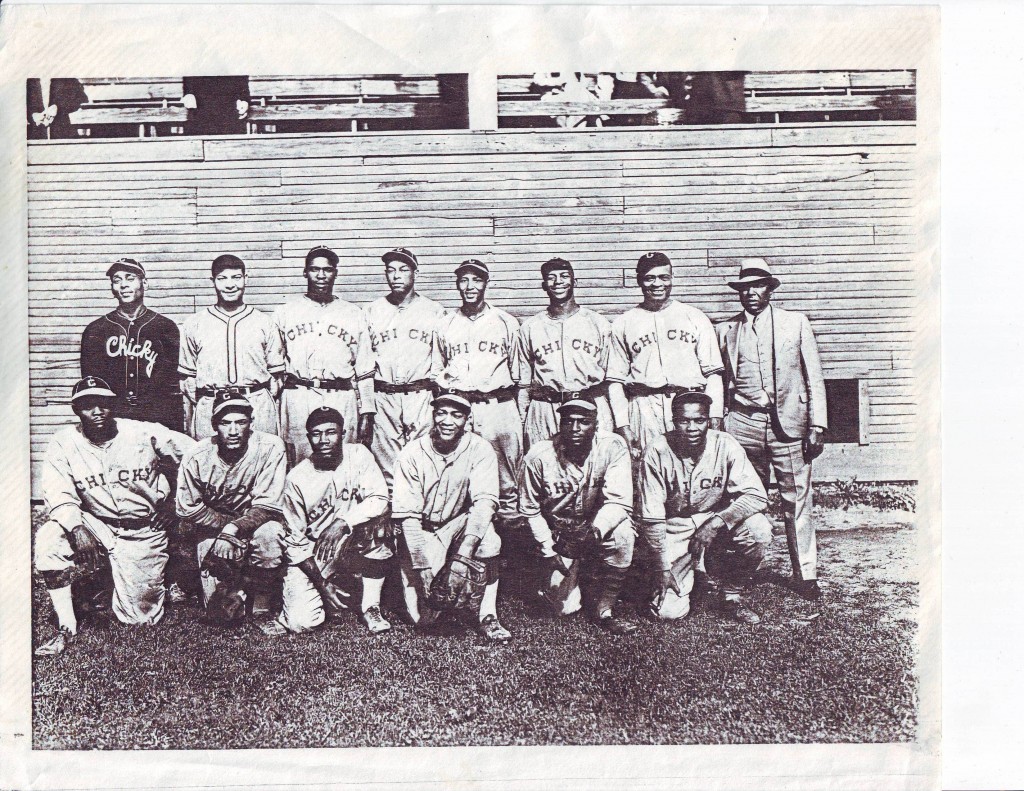
Frank Lamar’s Chicky Candy Bar Giants baseball team. Frank is the only man wearing a suit and is located in the top row on the far right. (12)
Mrs. Skinner’s Chicago Defender column, published on August 13, 1938, stated that “Club Indigo was the city’s only sepia night spot.” But even though Grand Rapids’ financially successful and socially prominent African-Americans had selected Club Indigo as the designated venue for their events, they did not own the building. In June of 1940, “Minstel Frolics,” a stage show and play composed of fifty characters, starring local musicians James Hugo and Bennie Keys, as well as police lieutenant Walter Coe, was staged at Ramona Park Theater. The benefits were to be used by Crispus Attucks American Legion Post # 59 for a youth recreational center. Walter Coe was the commander of the post at that time. This black-operated American Legion post, located at 243-5 Commerce Avenue S.W., was originally housed in the 1930s at 622 Sherman S.E. until 1939, then moved to the Commerce address in 1940. Their permanent charter was issued on May 21, 1931. This two-story building on Commerce S.W. was gradually becoming one of the primary locations for African-American social events in Grand Rapids. A key difference was that they now owned their own building
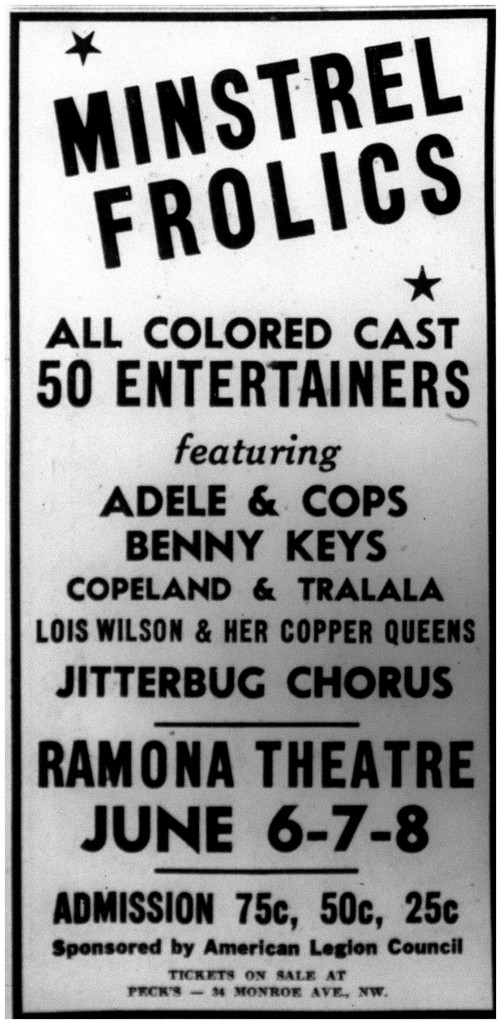
Ad for the Minstrel Frolics at Ramona Theatre featuring Benny Keys; June 1940 (13)
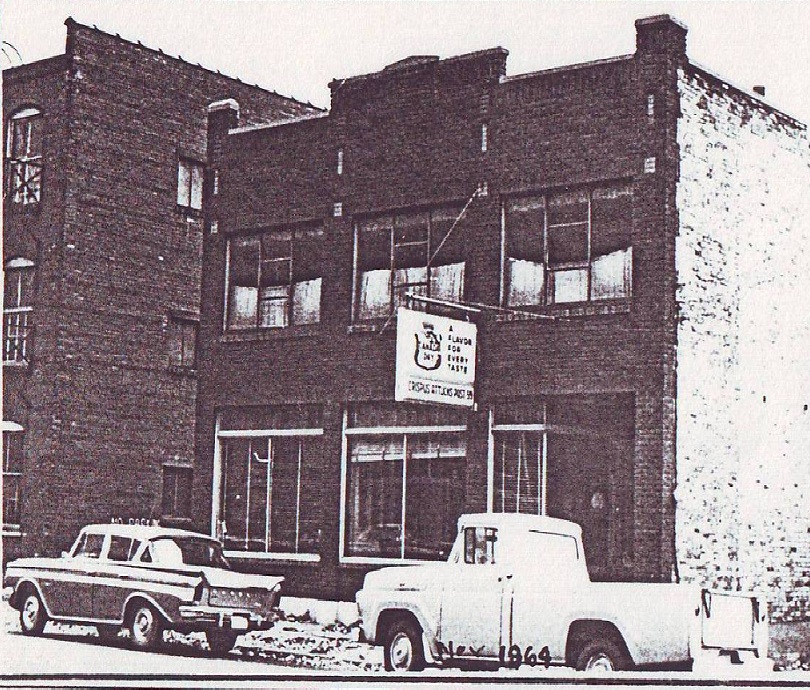
American Legion Post photo taken in November of 1964; from Grand Rapids City Assessor files, City Archives
In 1940, Dirk Fischer was one of a group of young men, many just out of high school, who were trying to establish themselves as jazz musicians in Grand Rapids. Glenn Litton, a music instructor at South High, inspired numerous students, including Dirk and his younger brother Clare, to obtain legitimate musical training. While still in high school, Frank Arrigo, Quentin “Sully” Sella, Johnny Bissell, Dirk Fischer and drummer Bill Anderson were performing at paid dances with Bob Watson’s band. Frank, Quentin, Johnny, Bill, Dirk, Clare, William “Jeep” Stewart, Rich Henry, Mike Balish, Arno Marsh, Dick Twelvetrees and Ernie Hoover were all actively seeking engagements and attending jam sessions at jazz venues like The Oasis, the Horseshoe Bar, Club Duke, Club Seville and Crispus Attucks American Legion. Bassist Ernie Hoover recalls playing at several jazz “breakfast dances” in the 40s and 50s at Roma Hall. “They would start around 11 P.M. and last until 7 A.M., and then the musicians would go out for breakfast.” The late Eddie “Koul” Azkoul ‘s jazz orchestras performed at Roma Hall. He began performing around 1938, and was also a part time disc jockey for WOOD radio. Arno Marsh, Clare Fischer and Rich Henry performed with his band in the 40s. Arno, the Fischer brothers and Rich Henry eventually became successful professional musicians. Roma Hall was one of the places where these young bloods met to play with fellow jazz musicians.
Dirk Fischer clearly recalls the unique looking gazebo-covered stage at Roma Hall, as well as performing there. “My experience at Russo (Roma) Hall was in the years 1940 through 1942. I was drafted on March 3, 1943 while playing an engagement with Rich Henry, Hamilton Allen and Mike Balish at Club Cheerio in Muskegon. I played at Roma Hall’s private parties, weekend dances, and jam sessions with Clare, Johnny Bissell, Mike Balish, maybe Rich Henry, Quenton Sella on trumpet, and a wonderful bassist we knew as “Rail” Wilson. Rail guided us and encouraged us in our pursuit of jazz and improvisation. Some of these events were all-black events, some mixed. I recall that the musicians were oblivious to the crowds and were only concerned with each other. There were various musicians that were in charge of the music. The word would go out that we could have a jam session and players were welcome. These were mainly on weekends.” (14)
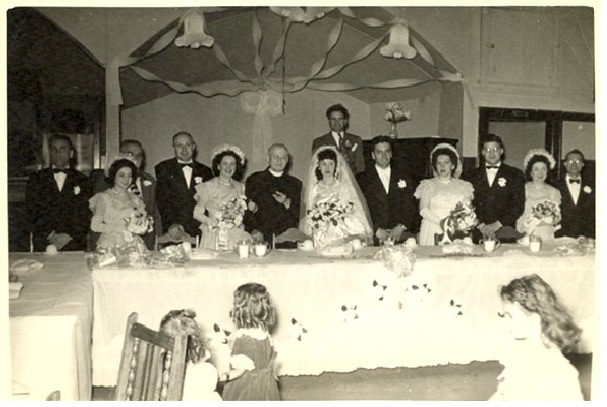
This is a picture of the wedding party for Frank and Mary Russo’s wedding at Roma Hall in 1941, with the stage centered in the background. Frank was G.B.’s only son. (15)
Frank Russo’s son John provided the following description for the layout of Roma Hall: “There was a restroom located behind the old gazebo stage. I recall an old clock that was hung near the stage area. There was also a large kitchen and bar located to the right of the old stage area, which was near the back alley stairway entrance that was accessed from Franklin Street. Bands used this stairway to transport their equipment up to the hall. We also had a large beer cooler that was still functioning when the building was demolished in 1991. There was a designated Roma Hall customer entrance on Division which featured a stairway to climb from the sidewalk up to the hall. In 1949, G.B. and my father Frank had an addition built, which was attached to the rear portion of the existing building. This expanded Roma Hall from 3652 to 5762 square feet. (16) [source of this information is from the 1951 GR City tax Assessors files.] At the time that the addition was built they installed two regular sized doors to allow passage between both halves of the hall.
But this area eventually became too congested during larger events. So in 1957 my dad decided to demolish the old gazebo stage, the restroom, and all the other clutter, located at the center of the hall. The two sides of the hall were then divided by two large garage (overhead) doors that could be either opened or closed, depending on the size of event. If two events were taking place simultaneously, then both doors were kept closed. If there was a second event, the people could use the back stairway to enter or leave.
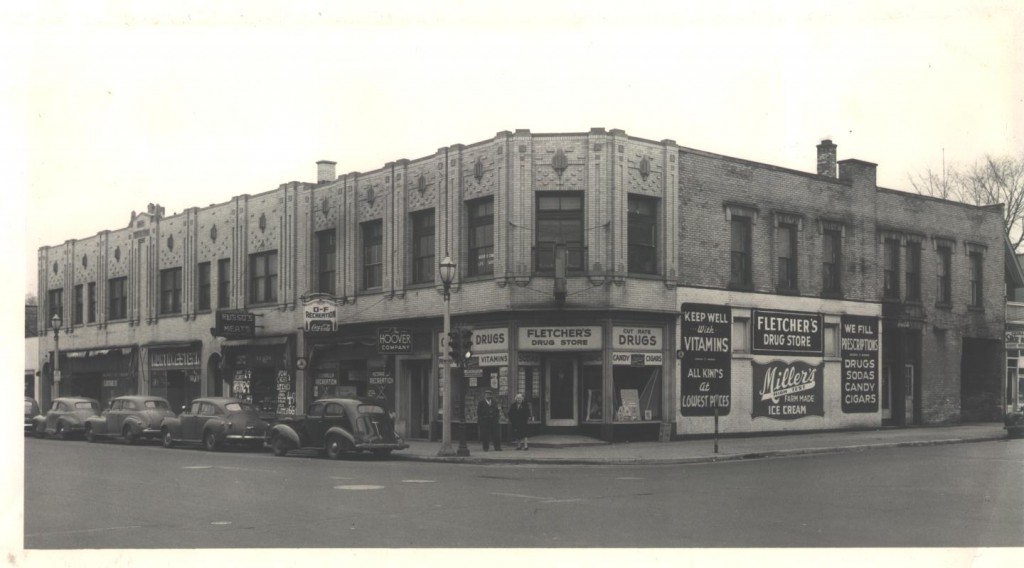
1940s view of the N.E. corner of Franklin and Division Avenue (Division is where the cars are parked.) To the extreme right is a large covered opening that leads to the rear stairway leading to Roma Hall. Roma Hall was located on the upper level of the left side portion of the photo.
Also, in 1957, a new portable stage was constructed which was typically positioned in the center of the north wall of the hall. At the same time that the addition was built, a tiny balcony with French doors, which faced south toward the courtyard, was included with this project. The doors were opened to provide ventilation on hot nights. We never had air conditioning in any part of the property.” (17)
From the 1930s until the 1980s Roma Hall was rented regularly by Grand Rapids’ African American community for a wide variety of events, including dances featuring high profile musicians. Nationally renowned musicians including Muddy Waters, B.B. King, Mary Wells, and James Brown performed for Roma Hall audiences in the 1950s and 1960s. When Motown Record’s first star, Mary Wells, came to perform at Roma Hall, she was escorted in a limousine by the label’s owner and producer Berry Gordy. In the early 60s, Joe Russo’s son Frank was working at the pizzeria underneath Roma Hall when The Primettes, an early version of the Supremes, stopped there for dinner after they performed.
Richard Weatherford, a photographer for The Grand Rapids Times during the earliest days of the newspaper, has stated that he booked Muddy Waters at Roma Hall. Grand Rapids resident Tom Mosley was a blues singer, guitarist and harmonica player for Little Wolf and the Gully Jumpers from the early 50s until 1970. His band opened for Muddy Waters at a dance “above the dime store (Fred Blymeir 5 & 10) at Russo’s Roma Hall. This is where I met Muddy Waters and James Cotton.”
Lee Virgins, who has been a singer in Grand Rapids since the 50s, is a close friend of soul and gospel recording legend Al Green. He sang with him at Roma Hall before Al became famous, and Lee now promotes gospel music shows. Virgins also clearly remembers two significant dances at Roma Hall. In 1955, he was twelve years old when B.B. King came to play at Roma Hall. He also recalls that in 1962 James Brown came to Grand Rapids to perform there, as well. Brown arrived in a 1954 Ford station wagon, and Lee helped the band move their equipment into the dance hall. (18)
Blues vocalist Bobby Blue Bland also played there in November of 1962. Reportedly, Jimmy Reed, Lavern Baker, Ruth Brown, Ray Charles, Tiny Bradshaw, T-Bone Walker, Percy Sledge, Lloyd Price, Amos Milburn, Lowell Folsum and Nappy Brown all appeared there, too, based on accounts by Jessie Strickland, Doug Cook, Tom Mosley, J.C. Carter, Annie Gant, Benny Keys, Jr., Lee Virgins, Raphael Gooch, and others.
At least some confusion exists because of the close proximity of another musical venue named the Rose Room, which was in business from 1953-1958. The Rose Room was located at 814 South Division and was situated on the same side of the street as Roma Hall. The buildings were no more than 300 feet from each other. Annie Gant told me that she clearly recalled seeing B.B. King at the Rose Room. Doug Cook saw B.B King at Roma Hall. Lee Virgins states that B.B. King’s tour bus was parked on Franklin Street, and was equipped with a black and white television. Furthermore, he helped haul King’s band’s equipment up the Roma Hall stairs. So it is quite likely that B.B. played at both places.

The Rose Room at 814 South Division, about a three minute walk from Roma Hall. (19)
While they were teenagers, Ed Hunnicutt and Charles Young worked for Rose Room owner Joshua “Pop” Haynes. They distributed placards and nailed up posters on telephone poles for upcoming shows in exchange for free tickets to these events. Ed talked to Amos Milburn at the Rose Room. He also recalls that T-Bone Walker, Lloyd Price, Lowell Fulsom, Percy Mayfield, Guitar Slim and numerous other black recording stars played at the Rose Room.
G.B.’s grandson, John Russo, recalls that Frank Lamar gave him and his brothers a ride in one of Frank Lamar’s new twin 1957 Cadillacs while Roma Hall was being set up for an event that Frank was sponsoring. Frank was a friend of the Russo family, and occasionally would enjoy dinner with G.B. and his family. John: “there were many African-American events which were held at our hall, sponsored by community leaders like Frank and Ted Raspberry.”
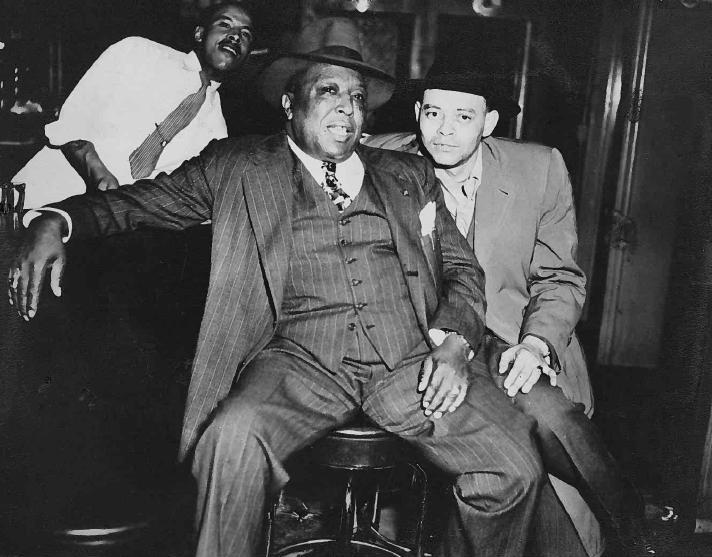
Left to right: Frank Lamar Jr., Frank Lamar and John Stribbling (20)
In the mid 1960s, when Al Green was still living in Grand Rapids, before he became famous, WERX radio station would hold dances at Roma Hall with Al Green and the Creations, and occasionally with recording stars like Major Lance performing. Lloyd Brown, also known as “Dr. Soul,” was a disc jockey for WERX at that time, and was involved with these dances. He was also a talented singer and drummer that performed in Grand Rapids clubs like the Blue Note and The Mouse Trap.
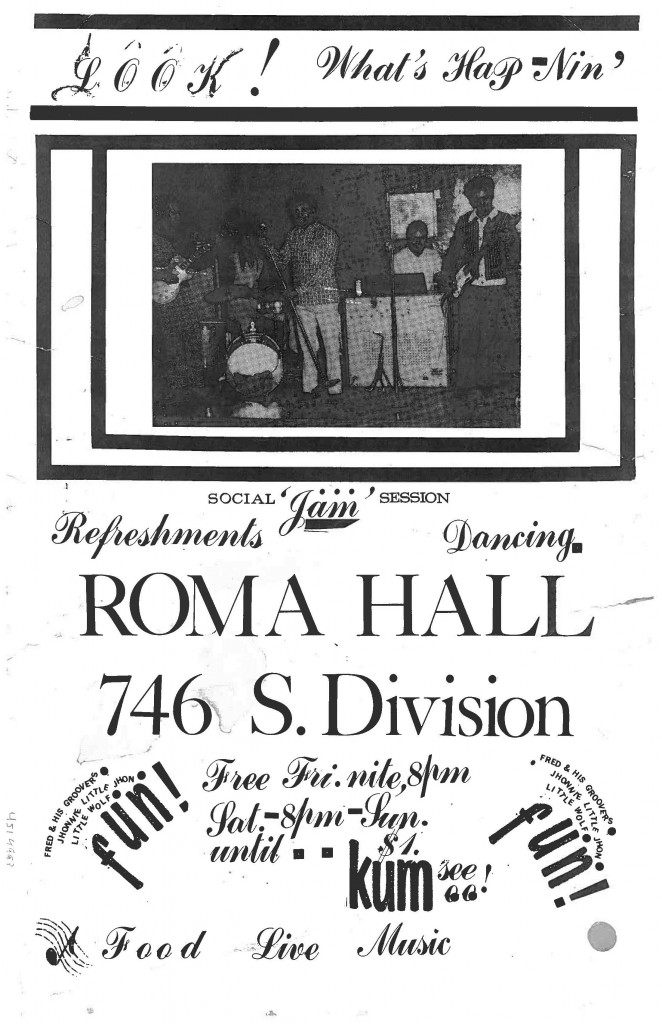
Around 1970, Little Wolf and the Gullyjumpers, Fred (Johnson) and the Groovers and their friend, Chicago bluesman Johnny Littlejohn played for a weekend dance at Roma Hall. (21)
Though only one of his numerous business inventions, Russo’s Roma Hall was used for a plethora of purposes and by several ethnic groups, spanning five decades. G.B.’s second wife and the family business bookkeeper, Giovannina (Jennie), preserved a generous quantity of family memorabilia including large ledger books, some related to bookings at Roma Hall. There were other family collections that were kept as well, and many of these items were stored in the vicinity of Roma Hall. After the roof collapsed over the dance hall in 1991, the family was not allowed access to the building. The Russo family was not allowed to salvage anything from their condemned buildings, including Jennie’s Roma Hall ledgers, as a wrecking crew worked to tear down and haul away the ruins of the old Russo complex.
Credits:
Primary credit is due to the grandson of G.B. Russo, John Russo, of Grand Rapids, Michigan, for his interest and enthusiasm concerning Russo family history and his remarkable patience with my endless questions about Roma Hall and Russo family history. Thank you, John!
I’d also like to express gratitude to Martin Starr, Russo family historian and genealogist, for his tireless assistance with questions about Russo family history.
A generous portion of Russo family history information was obtained from an unpublished document compiled by Jennie Russo Moschetti, Mary C. Russo, John Russo, and Frank D. Russo.
Thanks, also, to Frank Russo for helping me with Russo family history, as well as G.B.’s only surviving daughter, Jennie.
Thanks to Betty Forrest, Steve Smith, Arno Marsh, Mike Balish and Dirk Fischer for getting me hooked on local jazz history. Without Dirk, Arno and Steve’s help I would not be able to make any sense of local jazz history in the 1940s.
Arthur “Ed” Hunnicutt deserves immense credit for exposing me to the music, history and people of the Grand Rapids African-American community. Thank you, Ed.
Steve Jones, Ron Stephens and Randal Jelks have helped me begin to understand African-American history and have been very patient with me.
I’m certain that I have unintentionally forgotten a number of important people that have helped me in some way with this story. Please forgive me. (Kim Rush)
Footnotes:
- From the Robinson Photo Collection, property of Grand Rapids Public Library.
- Grand Rapids Press entertainment advertisement; 12.2.1933
- Dan Pliskow photo collection
- Curtis family photo collection
- Photo from Grand Rapids Times
- Chicago Defender; 9.26.1936
- Lamar family photo collection
- Chicago Defender; 2.6.1937
- Crisis Magazine; February, 1940
- Grand Rapids Times photo
- Chicago Defender; 7.13.1936 and 2.11.1938
- Lamar family photo collection
- Grand Rapids Press 6.2.1940 (Thanks to Gail Snow for directing me to this document)
- From 2010-2012 email conversations with Dirk Fischer
- Russo family photo collection property of John Russo
- Russo family photo collection property of Frank Russo
- Content gleaned from numerous email conversations with John Russo, 2011-2012
- Interviews and phone conversations with Lee Virgins, 2005-2012
- Grand Rapids City Archives; City Assessor file for 814 South Division S.E.
- Lamar family photo collection
- Poster provided by Arthur “Ed” Hunnicutt who deserves total credit for exposing me to the history and people of the Grand Rapids African-American community. Thank you, Ed.

One Response to Roma Hall Story